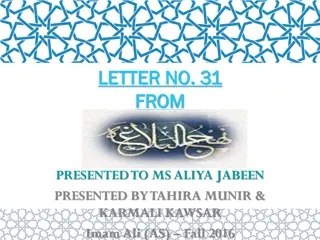OPEN LETTER Heidi Camacho.
Open letters serve as a powerful means of communication, reaching a wide audience while addressing specific individuals or entities. These public letters aim to spark discussion, advocate for change, or shed light on social issues. By maintaining a direct and persuasive tone, open letters engage readers and encourage responses, distinguishing themselves from private correspondences. Writers navigate a complex audience dynamic when crafting open letters, balancing the explicit audience addressed in the letter with the implicit audience they seek to persuade. Through adherence to letter-writing conventions and titles that identify the explicit readership, open letters leverage their accessibility and transparency to effect change and provoke discourse in society.
Download Presentation

Please find below an Image/Link to download the presentation.
The content on the website is provided AS IS for your information and personal use only. It may not be sold, licensed, or shared on other websites without obtaining consent from the author. Download presentation by click this link. If you encounter any issues during the download, it is possible that the publisher has removed the file from their server.
E N D
Presentation Transcript
OPEN LETTER Heidi Camacho 11/23/23 ENG 1101
WHAT IS AN OPEN LETTER? Two types of audience when it comes to an Open Letter: Literary Device A literary strategy known as the "open letter" genre enables the writer to address one audience while subtly influencing another, the "real" audience. Explicit Audience: the group the letter is addressed to. Implicit Audience: the group of people you re trying to persuade Heidi Camacho 2
THE TRICKY PART OF WRITING AN OPEN LETTER Open letters have a slightly more complex persuasive scenario due to the complex audience. In addition to presenting a more comprehensive case to their implicit audience, they must uphold the fiction of writing for their explicit audience. Heidi Camacho 3
HOW TO WRITE AN OPEN LETTER: Open letters frequently use letter writing standards from classic genres to identify their explicit readership (occasionally they even do this with the title: "An Open Letter to X."). Dear X, PRESENTATION TITLE 4
SUMMARY Open letters are written communications that are meant to be read by a large audience and frequently address a particular individual, organization, or thing. Open letters, in contrast to private ones, are exchanged or published in public via media such as newspapers, magazines, websites, and other channels. This literary method is distinguished by its ability to engage and impact a wide readership, in addition to its direct and convincing tone. Open letters are frequently used to voice thoughts, provide feedback, support policy changes, or draw attention to social issues. These letters hope to provoke public conversation and elicit a response from the intended recipient or society at large by their accessibility and transparency. Heidi Camacho 5























